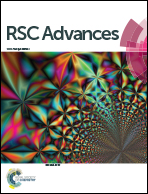2-(3′,4′-Dimethoxybenzylidene)tetralone induces anti-breast cancer activity through microtubule stabilization and activation of reactive oxygen species†
Abstract
Breast cancer is a leading cause of women mortality worldwide. Diverse analogues of 2-benzylidene tetralone have been synthesized and evaluated for anti-cancer activity against a panel of cancer cell lines. Among these, compounds 13, 15 and 19 exhibited potent anti-cancer activity (IC50 = 1–3 μM) against human breast cancer cells, MDA-MB-231 and non-toxic towards non-malignant cell line, HEK-293. Compounds 13, 15 and 19 significantly stabilized tubulin polymerization and arrested cell cycle progression at G0/G1 phase instead of typical mitotic arrest at G2/M phase as observed in case of tubulin polymerization modulators suggesting induction of mitotic slippage followed by cell death. Further, mechanistic studies revealed that compound 13 induced reactive oxygen species generation and apoptosis in breast cancer cells. Inhibition of ROS by N-acetyl-L-cysteine prevented compound 13 induced cytotoxicity. Compound 13 showed potent anti-cancer activity (74–79% tumour reduction) in syngeneic rat mammary tumour model without any adverse side effect. It was well tolerated up to 1000 mg kg−1 dose in acute oral toxicity. The identified lead molecule 13 may further be optimized for better activity.


 Please wait while we load your content...
Please wait while we load your content...